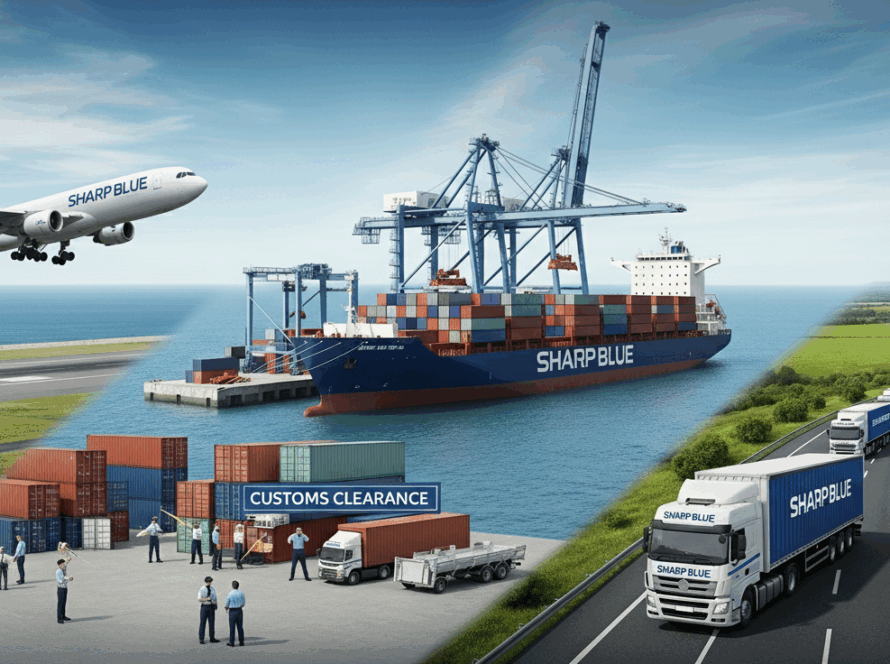In the world of logistics speed, efficiency and cost-effectiveness have always been the drivers of innovation. From cargo ships to rail, air freight to automation, every breakthrough has been about moving goods around the world better. A promising development in cross-border drone freight is the use of unmanned aerial vehicles (UAVs) for international cargo transport.
Drones have proven themselves in local deliveries, remote medical transport and emergency logistics. But when it comes to cross-border freight the question remains: Can drones bridge the gaps in international supply chains? In this blog by Sharp Blue, we look at the technical, current applications, challenges and future potential of drones in cross-border freight and ask if they are the missing link the logistics industry has been looking for.
The Growing Role of Drones in Logistics
Drones have moved from military to commercial logistics in a hurry as they can bypass the traditional infrastructure. Big companies like Amazon, UPS and DHL are testing drone delivery, focusing on last mile and humanitarian aid in remote areas. Drones have an advantage—bypassing traffic, reaching hard-to-reach areas and delivering on time where vehicles can’t.
While the last mile has gotten all the attention, the potential of drones in cross-border freight—across longer distances and across borders—is a different and more complex challenge.
Technical Advantages of Drones in Cross-Border Freight
To understand why drones are considered a game-changer, it’s important to highlight their technical advantages in logistics:
1. Autonomous Operation
It’s possible for some drones to fly autonomously thus lessening human dependency. Drones are capable of executing long-range routes with little or no human intervention—thanks to GPS, onboard sensors, and real-time navigation systems—operating across borders 24 hours a day and 7 days a week. They, hence, don’t get tired and are subject to no schedules.
2. Fuel Efficiency and Environmental Benefits
Most cargo drones, unlike conventional cargo aircraft, are electric, giving them a small carbon footprint. They use less energy and spew less waste. Hence, an eco-friendly alternative to traditional air freight options. This perk, of course, is extremely crucial, with the contemporary logistics industry trying to wade through environmental regulations and carbon reduction targets.
3. Bypassing Ground Infrastructure
One of the major upsides of drones is the fact that they can fly along direct paths, thereby bypassing some bottlenecks caused by bad or overcrowded infrastructure. Drones can fly over this infrastructure bottleneck and, therefore, are especially useful in border areas where geographical barriers of mountains or rivers, and sometimes poorly maintained roads, obviously slow the movement of regular transports.
Challenges: Why Cross-Border Drone Freight Isn’t Mainstream Yet
Despite their numerous advantages, deploying drones for cross-border freight presents several hurdles. These challenges span regulatory, technical, and logistical areas:
1. Regulatory Complexity
Airspace is the legal jurisdiction of any government of that country; some aviation regulations are quite disparate from country to country. Different terminologies are adopted with laws governing aerial activity like unmanned aerial vehicles by national aviation authorities; for instance, the USA has the FAA, while the European Union has the EASA. Therefore, authorities must establish coordinated regulatory standards for cross-border operations of unmanned aerial vehicles, a challenge that remains unsolved on a global scale.
Although the International Civil Aviation Organization (ICAO) has been working on a framework for the operation of internationally recognized UAVs, many countries remain far from reaching that milestone. Also adding to the complexity of greater drone operations are the customs and import/export regulations, which stipulate that cross-border transport involving goods shall remain compliant with customs clearance and tariff considerations.
2. Air Traffic Management and Safety
Drones must be integrated safely into manned air traffic, which is not a trivial task. Current air traffic management (ATM) systems are more suited for conventional aircraft, thus, there is a need to institute new unmanned traffic management (UTM) systems to be in charge of thousands of autonomous drones that have just begun to fly in the sky.
Issue related to the safety of mass deployment of fleets is critical; this becomes extremely sensitive when applied to communications of drones in densely populated city centers or politically sensitive zones. Authorities must resolve issues such as collision avoidance, bad weather, and access to communications links to ensure drone operations run safely and without interruptions.
3. Limited Payload and Range
Though operationally efficient, the payload capacity of cargo drones remains limited at this time. Most commercial drones are capable of carrying a payload of between 5-30 kg (payload capacity of drone), far below traditional truck or freight capacities. These drones also face limitations in range, as most can only cover between 100-150 km (60-90 miles) before needing to be refueled or recharged.
In a nutshell, if they were to work on large-scale freight, drone battery life should be improved or hybrid fuel models produced so that the environmental benefits they currently offer are not complicated.
Future Potential: Can Drones Fill the Cross-Border Gap?
Despite these challenges, the future of cross-border drone freight is promising. Here are a few key developments that could enable drones to play a larger role in international logistics:
1. Drone corridors
Countries like India and Rwanda have begun establishing dedicated drone corridors, which are airspaces reserved for UAV operations. If neighboring countries developed such corridors, international drone freight would gain control over conventional air traffic, enhancing safety and operational efficiency.
2. Tech Improvement
With improvements in battery technology solid-state batteries could massively expand the range of drones enabling them to fly international distances. Improvements in drone swarm technology, the ability for multiple drones to operate synergistically, would allow for more efficient cargo movement across borders.
3. Regulatory Harmonization
Countries around the world are slowly but surely moving in the direction of harmonizing UAV regulations. For international air freight carried by drones to become a reality, international aviation agencies like ICAO must pursue the establishment of universal standards that can apply across various national and airspace contexts.
Conclusion: Are Drones the Missing Link in Cross-Border Freight?
Drones have a lot of potential to change how we move things across borders by being faster, more eco-friendly, and more efficient than traditional ways of shipping. But, there are still some problems with technology, rules, and safety that need to be solved before drones can be used widely.
In certain situations—like delivering small, valuable, and urgent items—drones can really help with cross-border shipping. But for big, heavy loads or long trips, traditional shipping methods will probably still be the main choice.
In the end, while drones aren’t the perfect solution for cross-border shipping yet, they are a very promising and quickly improving option. If the rules and technology keep getting better, drones could soon be a big part of how we move things around the world—doing things that traditional methods can’t.



